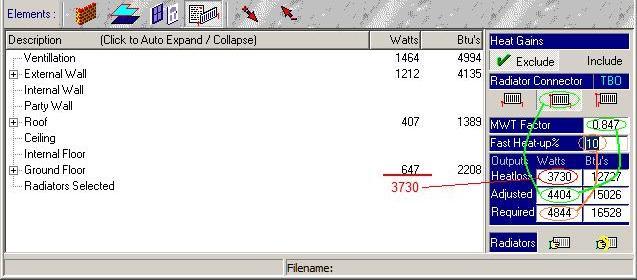I did the whole house method first & it came to 18.15 kw heat loss.
Does that include the 2kW for hot water?
Which region did you use?
the stars prog came out at 21kw heatloss.
Is that for 21C room and -1C outside?
I set the mwt to 65 as advised and stars prog said i needed 27kw with the hot water with the bigger rad sizes on 65 mwt.
The heat output required does
not change with water temperature, but the radiator output does. This is because a rad output depends on Flow, Return and Room Temperatures.
The Stars program is very confusing on this point and I get the feeling that they do not understand this themselves.
I will try to explain, using an example I quickly cooked up using Stars. It's a single storey one-room building 6m x 7m, 2.4m room height, fully insulated. The pic shows the heat loss summary and uses a MWT of 65C.
The "Heat Loss" is 3730 Watts. This is the actual loss, before any allowances.
The "Adjusted" figure takes account of the change in rad output with temperature and the effect of the type of connection. The MWT Factor is 0.847. This means that the radiator will only produce 84.7% of its specified output when you use a mean temp of 65C. So you have to put in a larger radiator, i.e 3730 ÷ 0.847 = 4404W. The connection show is TBSE (middle buton). If BBOE was selected (left button) the Adjusted figure would increase to 4492 Watts. This is because rads connected this way produce about 2% less heat.
The "Required" number is "Adjusted" plus the "Fast Heat-up %". In my example this adds up to 4844 Watts. This is the size of radiator you buy; it is
not the size of boiler you require.
You obtain the boiler size by increasing the heat loss (3730) by the "Fast Heat-up %" (10%), which gives 4103 Watts. To this you add the Hot Water Allowance (Sedbuk = 2kW, Stars = 2.5kW) This will give a boiler size of 6.1 or 6.6kW.
One thing I wasn't sure about was the ceiling temp in the program for the bedrooms. It automatically defaulted to -3, so I assume that's the worst case loft temp.
If your loft insulation is laid on the floor of the loft, the loft itself is not insulated, so the temperature inside the loft can fall to the outside temperature. That's why tanks and pipes in the loft have to be insulated.



